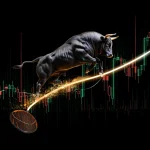
Inferno at the Open: Panic, Blood, and the Unforgiving Truth
May 7, 2025
You wake to a screen bathed in red—tickers collapsing, equity bleeding out, the market’s pulse spiking in arrhythmic terror. In that instant, your hands shake, not because you’re weak, but because every cell in your body screams survival. This is not a metaphor. It’s your limbic system—caveman wiring—flooding your bloodstream with cortisol, hijacking your logic, priming you for flight. And as your thumb hovers over the ‘sell’ button, so does everyone else’s. This is the anatomy of a financial stampede: one brain, multiplied by millions, echoing fear so loud it drowns out reason. This is where fortunes vanish and predators feast.
What is the DOW theory? Before you dismiss it as a relic, understand this: it isn’t just a set of rules—it’s a map of human panic, greed, and the paradoxical order in the chaos. The herds don’t read it. The wolves do. Markets are not efficient. They are wild, beautiful, and brutal arenas where psychology is destiny and history is a loaded gun pointed at your portfolio.
Anatomy of Panic: The Neurochemistry of Collapse
Every crash begins in the brain. Mirror neurons ignite a wildfire of mimicry; one trader dumps, another follows, then a thousand more—a self-replicating loop. The dot-com implosion, 2008’s global meltdown, the COVID crash: each was a live demonstration of herd instinct gone berserk.
In 2008, as Lehman Brothers imploded, you could practically smell the adrenaline on Wall Street. Traders, CEOs, janitors—all felt the same icy spike of dread. Uncertainty metastasised. Spreads blew out. The VIX, the so-called “fear index,” hit levels not seen in generations. What is the DOW theory? It’s the pattern beneath the panic, the set of principles that recognises how mass fear shatters trends, flips momentum, and reboots history.
The crowd can’t see this. They are trapped in the moment, prisoners of their amygdala, blind to the outlier events that rewrite everything. They sell at the bottom and wonder, later, why the market turned as if by magic. Cognitive dissonance leaves them bankrupt and bewildered.
The Wolves Move Different: Mindsets from the Fringes
While the masses convulse, a different breed circles the chaos. Jesse Livermore—he didn’t just survive panics, he orchestrated them. He knew that when the crowd’s fear peaked, the real opportunity began. John Templeton bought when the world was ending—literally World War II—because he understood that maximum pessimism was the birthplace of generational wealth. Ray Dalio dissects the system, looking for fractures and inflection points, anticipating the next paradigm shift before the herd even knows the game is changing.
But forget the legends for a moment. Consider the wolves you never see. The quantitative sharks parsing nonlinear signals, the shadowy funds trading volatility itself, the lone operator who feels the pulse of the market like a predator reading the wind. They thrive where the data is messy, where the crowd’s certainty breaks down. What is the DOW theory? It’s their playbook: confirmation, divergence, accumulation, distribution—the phases of crowd psychology disguised as technical signals.
To these contrarians, the market isn’t a puzzle to be solved; it’s a battlefield to be dominated. They study the cracks, the extremes, the moments when price action decouples from reality. They know that chaos isn’t the enemy—it’s the opportunity.
Fear as Fuel: Options Warfare in the Eye of the Storm
When terror peaks, premiums explode. This is when the true predators strike—not by buying when everyone else buys, but by selling fear itself. Selling puts during a VIX spike is the financial equivalent of walking into fire while others run. The crowd is desperate for protection; you become the insurer, pocketing fat, fear-soaked premiums.
Suppose Apple plunges during a market-wide rout. The panic is palpable, the puts are priced for Armageddon. You sell puts with a strike far below intrinsic value—collecting enough premium to make the risk worth the blood. But the play doesn’t stop there. As fear ebbs and markets stabilise, you funnel those premiums into LEAPS—long-dated calls, the patient predator’s weapon. You’re building a position for the rebound while the herd cowers in cash, licking their wounds.
This is not reckless gambling. It’s controlled chaos, engineered risk, asymmetric upside. The key is knowing when the panic is peaking, when the trend is exhausted, when the reversal is imminent. What is the DOW theory? It’s the lens that sharpens your vision—showing you the shift from distribution to accumulation, from collapse to rebirth.
Calculated Aggression: The Blueprint for Survival
There’s a razor-thin line between courage and carnage. The market rewards precision, not bravado. Every move must be mapped: position sizing, hedges, exits, re-entries. Risk is not something to avoid—it’s something to weaponise, to sculpt into a tool sharper than fear itself.
Think like a sniper. Every shot is deliberate. Discipline is your shield; patience, your sword. You wait, observe, and confirm. When the DOW theory flashes a signal—a primary trend exhausted, a secondary trend emerging—you act with decisive clarity. No hesitation. Confidence without calculation is suicide.
In the end, this isn’t YOLO roulette. It’s war. What is the DOW theory? It’s the doctrine that distinguishes the tactician from the casualty, the blueprint that allows you to cut through noise and seize the outlier moment when risk and reward go exponential.
Exit Velocity: Breaking Free from the Mob
This is the crux: most will never escape. The mob is a prison of consensus, a cage built of borrowed conviction and second-hand fear. Breaking free is brutal—it means thinking for yourself, questioning every premise, standing alone in the storm while the crowd howls for safety.
But for those who do, the game changes. You don’t just make money; you seize autonomy. You become the architect of your fate, the master of your narrative. The market transforms from a threat to a hunting ground, from a source of anxiety to a proving ground for personal power.
What is the DOW theory? It’s more than a market model. It’s a philosophy of independence, a method for extracting signal from noise, a ritual for transforming chaos into opportunity. It’s the secret language of the wolves in a world of sheep.
Paradox, Emergence, and the Final Edge
Here’s the final paradox: Markets are never just one thing. They are certainty and chaos, order and entropy, greed and fear—overlapping, colliding, creating emergent patterns no rulebook can predict. What is the DOW theory? It’s a framework for reading these contradictions, for seeing the invisible architecture beneath the turbulence.
The edge isn’t in following the rules; it’s in understanding when the rules bend, break, or reverse. It’s seeing how outliers don’t just disrupt—they define. Every crash plants the seed of the next bull run. Every panic births a new cohort of predators.
To operate here is to become a vector thinker: mapping flows, sensing shifts, layering insights from psychology, physics, even mythology. The market is a living, breathing organism, and its patterns are fractal—self-similar at every scale, but always ready to mutate.
So, you want to know what is the DOW theory? It’s the scaffolding beneath the madness, the playbook for those who thrive in contradiction, and the invitation to step beyond the mob into the realm of deliberate, dangerous independence.
Leaving a Mark: Impactful Articles












